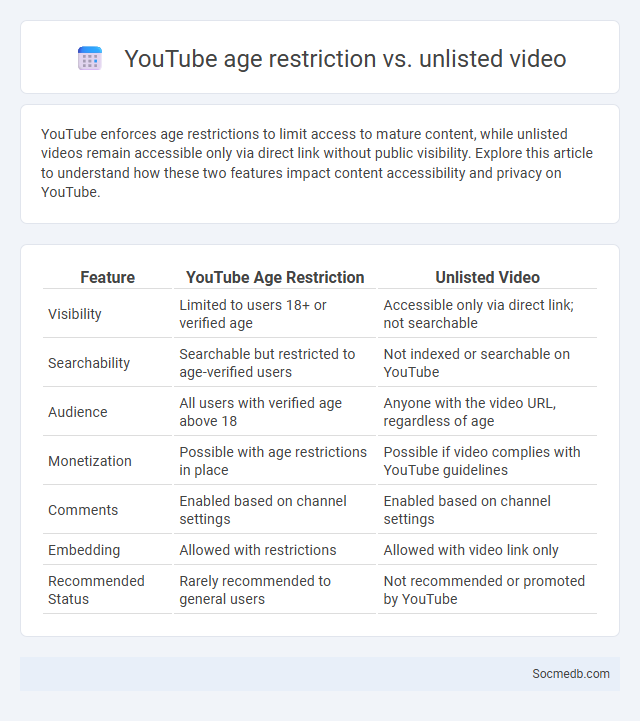
Photo illustration: YouTube age restriction vs unlisted video
YouTube enforces age restrictions to limit access to mature content, while unlisted videos remain accessible only via direct link without public visibility. Explore this article to understand how these two features impact content accessibility and privacy on YouTube.
Table of Comparison
| Feature | YouTube Age Restriction | Unlisted Video |
|---|---|---|
| Visibility | Limited to users 18+ or verified age | Accessible only via direct link; not searchable |
| Searchability | Searchable but restricted to age-verified users | Not indexed or searchable on YouTube |
| Audience | All users with verified age above 18 | Anyone with the video URL, regardless of age |
| Monetization | Possible with age restrictions in place | Possible if video complies with YouTube guidelines |
| Comments | Enabled based on channel settings | Enabled based on channel settings |
| Embedding | Allowed with restrictions | Allowed with video link only |
| Recommended Status | Rarely recommended to general users | Not recommended or promoted by YouTube |
Understanding YouTube's Age Restriction Policy
YouTube's age restriction policy limits access to content deemed inappropriate for viewers under 18, ensuring compliance with legal and community standards. Videos featuring mature themes, explicit language, or graphic content are flagged and require users to sign in and verify their age before viewing. This policy helps protect younger audiences while allowing creators to publish diverse material within YouTube's content guidelines.
What Is an Unlisted YouTube Video?
An unlisted YouTube video is a type of video that does not appear in YouTube search results, your channel, or subscriber feeds, ensuring limited visibility. Only people with the direct link can view and share the video, making it ideal for private sharing or selective distribution without public exposure. You can control who accesses your content while maintaining the flexibility to share it with specific viewers.
Key Differences Between Age Restriction and Unlisted Videos
Age restriction on social media limits video visibility based on the viewer's age, requiring users to verify their birthdate before accessing content, effectively protecting minors from inappropriate material. Unlisted videos do not appear in search results, recommendations, or public profiles, and can only be viewed by those with a direct link, ensuring controlled sharing without age limitations. Unlike age-restricted content that enforces user eligibility, unlisted videos prioritize privacy and selective audience access without filtering based on age.
Benefits of Using Age Restriction on YouTube
Implementing age restrictions on YouTube helps protect younger audiences from inappropriate or harmful content, ensuring a safer online experience for your children or teens. This feature allows creators and platforms to comply with legal regulations, reducing liability related to content exposure. Age restrictions also promote responsible content consumption, enabling YouTube to offer tailored recommendations suitable for different age groups.
Pros and Cons of Uploading Unlisted Videos
Uploading unlisted videos on social media offers privacy by restricting access to only users with the link, which enhances content control and targeted sharing. However, this limited visibility reduces potential audience reach and engagement metrics, impacting organic growth and feedback opportunities. Content creators must balance confidentiality with visibility needs when utilizing unlisted video settings on platforms like YouTube or Facebook.
How to Enable Age Restriction on Your YouTube Content
To enable age restriction on your YouTube content, access the YouTube Studio and navigate to the "Content" section where your videos are listed. Select the video you want to restrict, click on "Visibility," then choose "Age restriction (advanced)" and specify the age limit to comply with YouTube's community guidelines. Ensuring age restrictions are properly set protects your content from being viewed by underage users and aligns with YouTube's policies for sensitive or mature material.
When Should You Choose Unlisted Over Age Restricted?
Choosing unlisted videos over age-restricted ones is ideal when you want to share content with a specific audience without limiting accessibility based on age verification. Unlisted videos prevent search engines from indexing the content and restrict it to users with the direct link, ensuring controlled visibility without the strict limitations imposed by age restrictions. This approach is effective for content that is appropriate for general audiences but not intended for broad public discovery on platforms like YouTube.
Impact of Age Restrictions on Video Reach and Analytics
Age restrictions on social media platforms significantly limit the reach of your video content by filtering out audiences below a specified age, thereby reducing potential views and engagement metrics. These restrictions also affect analytics accuracy, as the data reflects a narrower demographic, making it challenging to gauge overall performance or optimize targeting strategies. Understanding how age limitations shape video visibility helps you tailor content and marketing efforts for better reach and effectiveness.
Legal and Community Guidelines for YouTube Age Limits
YouTube enforces strict age limits to comply with legal regulations such as the Children's Online Privacy Protection Act (COPPA), requiring users to be at least 13 years old to create an account. The platform's Community Guidelines prohibit content that exploits or targets minors, ensuring a safe environment by restricting age-inappropriate videos and comments. Violations of these policies result in content removal, account suspension, or termination to protect underage users from harmful or explicit material.
Best Practices for Managing Sensitive or Private YouTube Content
Managing sensitive or private YouTube content requires strict adherence to privacy settings, such as setting videos to unlisted or private to control audience access. Implementing careful content categorization and tagging enhances search optimization while protecting user privacy. Regularly reviewing comment moderation and employing YouTube's content ID tools further safeguard sensitive material from unauthorized use or exposure.
 socmedb.com
socmedb.com